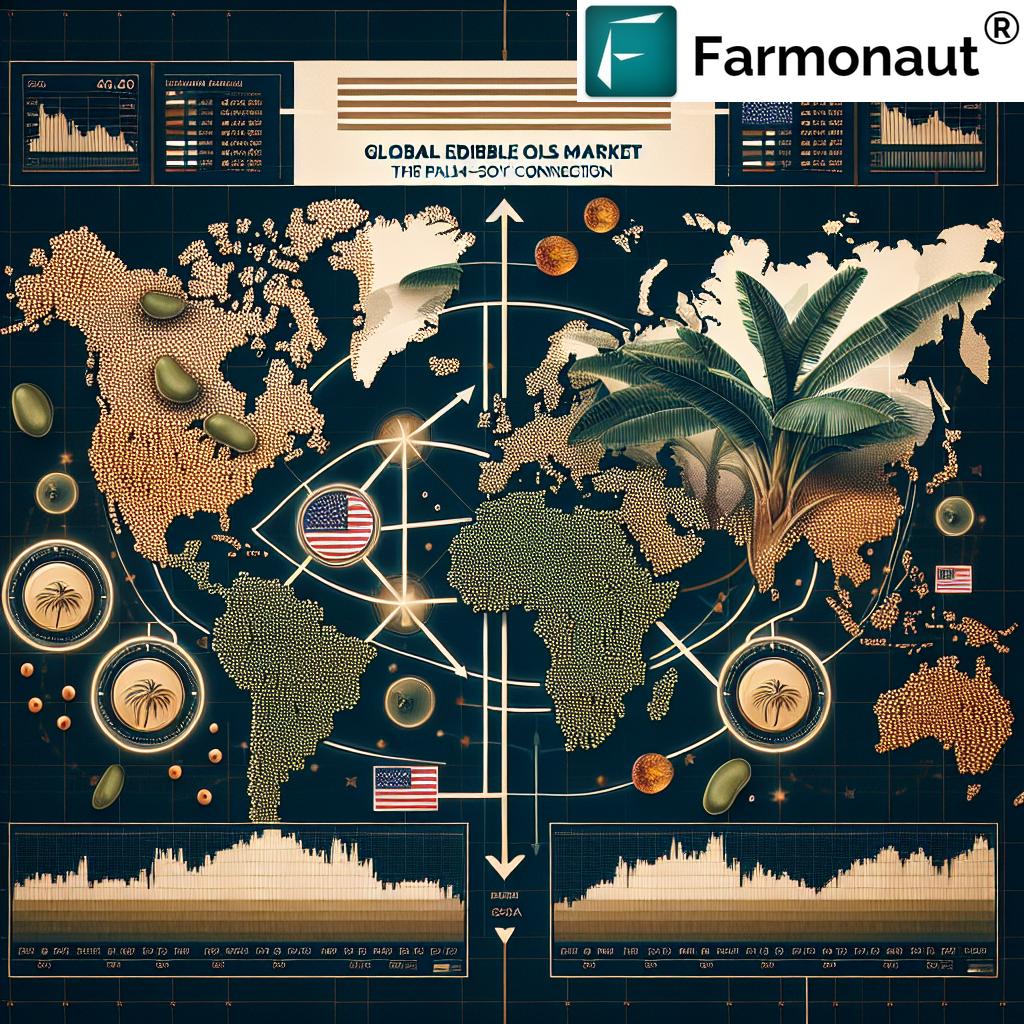Unlock the Secrets of Soaring Soybean Oil: How Palm Oil’s Surge Is Revolutionizing the Global Edible Oils Market

In a surprising turn of events, the global edible oils market is witnessing a remarkable shift, with soybean oil futures and palm oil prices taking center stage. This article delves into the intricate dynamics of the vegetable oil market, exploring how recent developments are reshaping the industry landscape.
The Soybean Oil Rollercoaster
The soybean harvest of 2024 has been nothing short of a rollercoaster ride for soybean oil futures. On August 16, the market experienced a significant downturn, with prices plummeting to a four-year low. This dramatic drop was triggered by the U.S. Department of Agriculture’s (USDA) August Crop Production report, which projected record-breaking soybean production and yield for the 2024 crop.
However, the market’s response to this bearish forecast was short-lived. Since mid-August, soybean oil futures have demonstrated remarkable resilience, surging by nearly 13%. This upward trend persisted despite the ongoing harvest of a massive domestic crop and increasing stock levels.
Palm Oil: The Unexpected Market Driver
The key to understanding the current soybean oil price trends lies in the palm oil market impact. As Brian Harris, executive director and owner of Global Risk Management, succinctly put it, “Palm oil is leading everything up.”
Since April, palm oil prices have been on a steady upward trajectory, reaching two-year highs. This persistent increase in the world’s most consumed vegetable oil has established a solid price floor for other global edible oils, including soybean oil, which dominates the U.S. market.

Factors Driving Palm Oil’s Surge
Several factors are contributing to the current palm oil market dynamics:
- El Niño impact on palm production: Extended dryness from the El Niño weather pattern has raised concerns about lower 2024 palm oil output in Indonesia and Malaysia.
- Aging trees and poor husbandry: Cost-cutting measures and a reduced labor pool have led to suboptimal care for palm oil plantations.
- Indonesian palm oil production: The USDA has reduced its forecast for Indonesian 2024-25 palm oil production by 500,000 tonnes to 46.5 million tonnes.
- Dwindling stocks: The Indonesian Palm Oil Association reported that August 31 stocks were at their lowest since March 2019.
For those interested in tracking these agricultural trends, Farmonaut’s satellite-based crop monitoring app provides valuable insights:
Indonesian Biodiesel Policy Effects
Adding further complexity to the vegetable oil market dynamics is Indonesia’s proposed policy to increase its mandatory biodiesel blend. The plan aims to raise the palm oil-based content from the current 35% to 40% by 2025. This Indonesian biodiesel policy is expected to intensify domestic consumption, potentially straining an already tight supply situation.
For developers looking to integrate agricultural data into their applications, Farmonaut’s API offers comprehensive satellite and weather data. Detailed documentation is available in the API Developer Docs.
Global Edible Oils Supply: A Delicate Balance
The current situation highlights the delicate balance in the global edible oils supply chain. With Indonesia and Malaysia accounting for nearly 85% of global palm oil production, any fluctuations in their output can have far-reaching consequences for the entire vegetable oil market.
The USDA’s October Oil Crops Outlook paints a telling picture:
- Global 2024-25 palm oil ending stocks forecast reduced by 1.5 million tonnes to 16.1 million tonnes.
- Indonesian 2023-24 palm oil production estimate cut by 2.5 million tonnes to 44 million tonnes.
These adjustments reflect lower-than-expected harvested acreage and yield, underscoring the impact of environmental and policy factors on agricultural output.
Agricultural Commodity Futures Analysis
The current market conditions present a complex landscape for agricultural commodity futures analysis. Traders and analysts are closely monitoring several key factors:
- USDA crop forecasts: Regular updates on soybean and palm oil production estimates.
- Weather patterns: Ongoing assessment of El Niño’s impact on major production regions.
- Policy changes: Potential shifts in biodiesel mandates and trade policies.
- Global demand trends: Fluctuations in consumption patterns across different regions.
For those looking to stay ahead of these market trends, Farmonaut offers mobile apps for both Android and iOS platforms:
Looking Ahead: Market Implications
As the vegetable oil market continues to evolve, several key implications emerge:
- Price volatility: Expect continued fluctuations in soybean oil and palm oil prices as markets adjust to supply constraints and policy changes.
- Supply chain adaptations: Food manufacturers and biodiesel producers may need to reassess their sourcing strategies and inventory management practices.
- Agricultural practices: Increased focus on sustainable palm oil production and exploration of alternative oilseed crops.
- Policy considerations: Governments may need to balance biofuel mandates with food security concerns.
Conclusion
The surge in palm oil prices and its ripple effect on soybean oil futures underscores the interconnected nature of the global edible oils market. As environmental factors, policy decisions, and market dynamics continue to shape the industry, stakeholders across the supply chain must remain vigilant and adaptable.
For those seeking to navigate these complex market conditions, tools like Farmonaut’s satellite-based crop monitoring and weather forecasting can provide valuable insights. By leveraging advanced technology and data analytics, industry participants can make more informed decisions in an increasingly volatile market landscape.
As we move forward, the balance between sustainable production, food security, and renewable energy goals will continue to play a crucial role in shaping the future of the global edible oils market. Stay tuned for further developments in this dynamic and essential sector of the agricultural commodity market.


